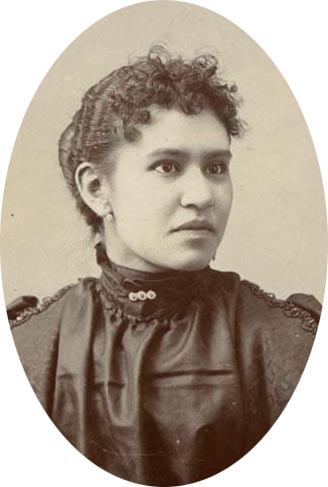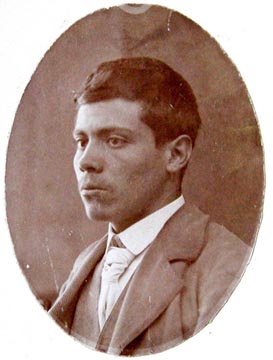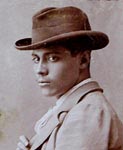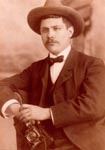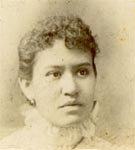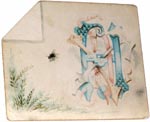Beginnings in Zacatecas
Born on February 2, 1877, in the city of Zacatecas, Mexico, the second son of Julian and Rafaela Rivas was named Candelario in honor of being born on St. Blaise's Day (Candlemas). His brothers were named Felix and Concepción, and all three of them painted. The one daughter was named Manuela, but died as a child from injuries received during a fall. Julian Rivas learned to read and write only in his later years, but he brought to his sons a deep respect for family, humility, and personal honor.
From the start, the life of Candelario Rivas was that of an exceptionally gifted artist. As a child, he would forgo playing with other children to spend quiet time drawing with whatever medium he could find. And so absorbed was he in perfecting his drawings, that he cried when he did not have the colors he needed to give them life. It was a Franciscan priest who first gave the young artist a set of watercolors, and with these, the boy artist painted brilliant renditions of Our Lady of Guadalupe and St. Anthony, which he sold to his classmates.
One day, at the age of twelve, the young Candelario witnessed a traveling circus set up for business in Zacatecas. Profoundly impressed with the vivid colors of the large circus paintings, Candelario dropped his mother a letter after a show to inform her that he was leaving with the circus to learn the exciting artform of the circus poster. However, Rafaela never received the note, and after two weeks the family feared the worst for their lost son.
But Candelario returned after two months to find his family overjoyed to see him, and understandably upset at his unannounced departure.
The historical city of Zacatecas provided an ideal environment for the budding artist. Built between hills and steep slopes, the city has been called a labyrinth of artistic and cultural treasures. And with a foundation of thriving silver mining, agriculture, a state government, and an established Church, Zacatecas had the economy to support a rich tradition of art. Although the modern city still exhibits much of its history, it has never fully recovered its economic strength since the 1914 revolution.
In his teens, Candelario continued his self education in fine art by working with painters as they decorated the interior walls and ceilings of prestigious haciendas, some of which are maintained to this day. With the income and education Candelario gained from interior decoration, he was able to secure the oil paints and high quality canvases required to broaden his skills. Soon he was making progress in painting life-size figures in various religious themes, much in line with the great masters such as Ingres, Murillo, and Cabrera. The youthful Candelario Rivas was now securing his own commissions, and with them came his first recognition as a talented fine artist, especially when it was learned that he was self-taught in his use of colors and techniques of classical style.
In 1893, the City of Zacatecas began the restoration of its historical cathedral. Assigned as the general contractor was a Señor Don Rafael León. It was his decision to have three large murals made; one on the background behind the main altar, and one each for the two lateral naves. The mural behind the altar was assigned to the distinguished artist Señor Pastrana, who had received a degree from the prestigious Academy of San Carlos in Mexico City. The murals for the two lateral naves were commissioned to Professor Almanza, who was also a well-known and distinguished artist from the same institution. But as the work on the first nave's mural progressed at a slow rate, it became obvious that Professor Almanza would not be able to complete his second mural of The Agony in the Garden on time. Aware of the unusual talent of the seventeen-year-old Candelario Rivas, Señor Don Rafael León assigned him to paint the remaining mural. This proved to be Candelario's first great success; it earned him praise from the local press, and he came to be known as "the Zacatecan artist".
By the time he reached his twentieth year, Candelario was working with his second cousin, Refugio Reyes Rivas, the self-taught and soon to be renowned architect. It was this cousin who commissioned Candelario to decorate the interior walls of his magnificent baroque-like designs.
Of the few remaining facts we have of the Julian Rivas family, we know that the eldest son Felix came upon difficult financial times, and moved his family of seven back to his parent's small house. Candelario's wife, Herlinda, saw the hard work it brought upon Rafaela and insisted that she and Julian live with them in the spacious house that Candelario had bought. Sadly, Rafaela died in residence there at the age of forty-two. Concepción, riding with his wife in boxcars and other available means, actually made his way to Candelario's house in Los Angeles, but returned to Zacatecas when he found no work in California.
Herlinda de la Torre grew up with her mother in Zacatecas under very limited means. Her father, a Spanish businessman, had vanished on a trip to Spain while she was an infant. But her mother remained dedicated to her only daughter and supported her with the best education she could afford by making and selling cigars in the city market. They lived happily in a very small house where they shared the only bed they had. In 1895, at the age of fifteen, Herlinda awoke horrified to find her young mother dead, next to her in bed. The cause of death was never established, but it was assumed to be from a heart ailment. With no family to come to her aid, she courageously continued with her fast-paced education and earned college degrees in astronomy and mathematics in 1898.
However, she did not spend her years in college alone. Her close friend, Carolina, invited her to live with her family, who were financially secured. Herlinda accepted the generous offer and the two became closer friends and shared recreational times together. One year before Herlinda completed her studies, she joined Carolina on a walk to a neighborhood church to see a new artist named Candelario Rivas work on ceiling murals high on scaffolding structures.
Herlinda was amazed upon seeing a very handsome young man with beautiful green eyes, not an old and bearded artist she was expecting to see.
Meanwhile, Candelario had taken a second job in the evening consisting of developing graduation pictures of a new class of teachers. One evening, he was so intrigued to see such beauty and innocence in one of the portraits, that he made an additional copy for himself to keep in his pocket. Several months later, Carolina's mother invited the young Zacatecan artist to their home for dinner to give her daughter the chance to meet him. Since Herlinda was living with the family then, she was part of the dinner party that evening.
We can imagine Candelario's astonishment when he was introduced to Herlinda; the unknown beautiful lady in the photograph he had kept. After that moment in 1897, in Zacatecas, Mexico, it was always Candelario and Herlinda. They married in 1898, and as their early love letters describe (translated below), they felt an undying love for each other. They lived to celebrate their fiftieth anniversary, and as Candelario suggested, a love of eternal dimensions.
